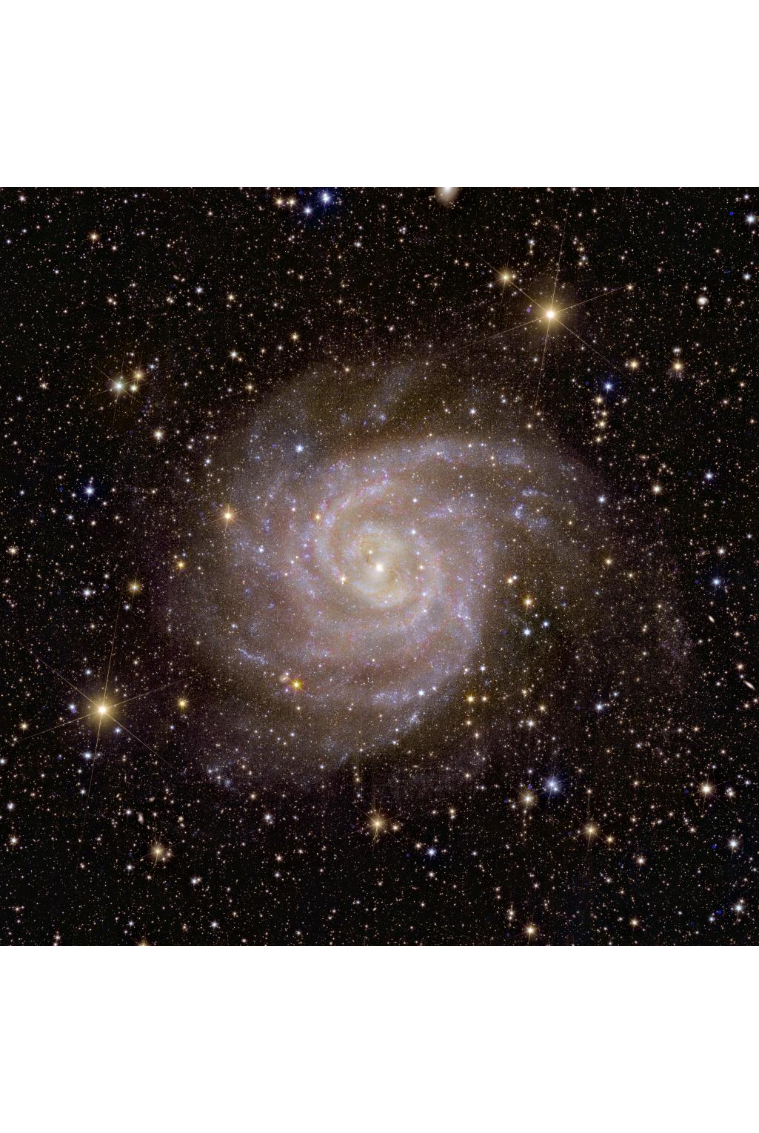It looks like you're using an Ad Blocker.
Please white-list or disable AboveTopSecret.com in your ad-blocking tool.
Thank you.
Some features of ATS will be disabled while you continue to use an ad-blocker.
15
share:
Hidden no more , IC 342 or Caldwell 5 is called "the hidden Galaxy" because it is obscured by the disk of our Milky Way but thanks to Euclid's
incredible sensitivity and superb optics it's been revealed in all its spirally glory , looking much like our own Galaxy Caldwell 5 sits 10.76
million light years from Earth and contains around 100 billion Stars , it measures about 50,000 light-years across.

Euclid was launched on 1st July 2023 and inserted into Lagrange point L2 about 1.5 million kilometers beyond Earth's orbit , its mission is to help us understand dark energy and dark matter (if they exist) by accurately measuring the accelerating expansion of the universe , and send back pretty pictures using its 600-megapixel camera and determine Redshift of Galaxies it sees using its near-infrared spectrometer, and photometer.
Euclid's first images: the dazzling edge of darkness.
www.esa.int...

Euclid was launched on 1st July 2023 and inserted into Lagrange point L2 about 1.5 million kilometers beyond Earth's orbit , its mission is to help us understand dark energy and dark matter (if they exist) by accurately measuring the accelerating expansion of the universe , and send back pretty pictures using its 600-megapixel camera and determine Redshift of Galaxies it sees using its near-infrared spectrometer, and photometer.
Euclid's first images: the dazzling edge of darkness.
ESA’s Euclid space mission reveals its first full-colour images of the cosmos. Never before has a telescope been able to create such razor-sharp astronomical images across such a large patch of the sky, and looking so far into the distant Universe. These five images illustrate Euclid's full potential; they show that the telescope is ready to create the most extensive 3D map of the Universe yet, to uncover some of its hidden secrets.
www.esa.int...
a reply to: FullHeathen
Yes it is quite mind bending , Euclid orbits a single point in space which is the Lagrange point 2 , it keeps a relative distance from Earth while following it in its orbit of the sun.
This graphic explains it better than I can.
Yes it is quite mind bending , Euclid orbits a single point in space which is the Lagrange point 2 , it keeps a relative distance from Earth while following it in its orbit of the sun.
This graphic explains it better than I can.
If you think its only possible be held in orbit around a central body of mass - say a planet or a star - you'd be wrong. It is in fact possible to orbit around an invisible point, an oasis of forces, infinitesimal in size. ESA’s Euclid mission was launched on 1 July 2023 to uncover the secrets of the dark universe. Its destination? Like many astronomy missions before it, Lagrange point 2.
‘L2’ is an ideal location for astronomy missions because they can keep the Sun, Earth and Moon behind them at all times, so they don’t interfere with observations, while at the same time getting a clear view of deep space and pointing an antenna back to Earth to remain in close communication. The permanent sunlight on Euclid at L2 also keeps the telescope thermally stable, allowing for the extremely high stability required for the instrument’s long exposure observations.
Euclid’s orbit around Lagrange point 2 is big. In terms of distance, the ‘radius’ of Euclid’s orbit varies from about 400 000 kilometres at its closest to the centre, and up to 800 000 kilometres at its furthest. By the time Euclid has completed one full revolution around L2, the Moon will have circled the Earth six times.
The reason for this large orbit is that it is almost free, in terms of fuel, to get there. The better the accuracy of the rocket that launches a mission into such a large halo orbit around L2, the less fuel that’s needed to perform correction manoeuvres – and Euclid only required a tiny correction manoeuvre after its near-perfect launch on a Space X Falcon 9.
new topics
-
Ford Motor Company sold to Elon Musk
Other Current Events: 3 hours ago -
President Biden pardons his son Hunter Biden
US Political Madness: 7 hours ago -
Biden pardons his son Hunter despite previous pledges not to
Mainstream News: 7 hours ago -
Studies show that watching a beaver eat cabbage lowers stress by 17%
Health & Wellness: 11 hours ago
top topics
-
Biden pardons his son Hunter despite previous pledges not to
Mainstream News: 7 hours ago, 12 flags -
James Webb Telescope Takes a Look at the Sombrero Galaxy
Space Exploration: 15 hours ago, 11 flags -
President Biden pardons his son Hunter Biden
US Political Madness: 7 hours ago, 11 flags -
Australia passes social media ban for children under 16
Social Issues and Civil Unrest: 15 hours ago, 6 flags -
Salvatore Pais confirms science in MH370 videos are real during live stream
General Conspiracies: 12 hours ago, 5 flags -
Studies show that watching a beaver eat cabbage lowers stress by 17%
Health & Wellness: 11 hours ago, 4 flags -
Ford Motor Company sold to Elon Musk
Other Current Events: 3 hours ago, 0 flags
15
